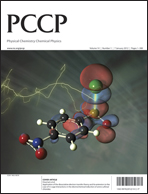II 型 MoSi2As4/MoGe2N4 光伏 vdW 异质结构中超过 22% 的功率转换效率
IF 2.9
3区 化学
Q3 CHEMISTRY, PHYSICAL
引用次数: 0
摘要
如今,先进太阳能电池材料的开发取得了重大进展,包括高性能二维(2D)材料,如掺杂镓硒、过氧化物和氧化物,以及它们的范德华(vdW)异质结构。这些努力的目标是提高光伏效率、降低成本和减少对环境的影响。尽管如此,在改善光吸收、载流子迁移率和功率转换效率(PCE)方面仍然存在挑战,这凸显了对具有增强光电特性的材料的需求。在这里,我们构建了一种二维 MoSi\textsubscript{2}As\textsubscript{4}/MoGe\textsubscript{2}Ntextsubscript{4} vdW 异质结构,层间距为 3.39 Å,具有 1.14 eV 的间接带隙和 II 型带排列。计算评估表明,光生电子能有效地从 MoSi (MoSi)层转移到 MoGe (MoGe)层,而空穴则向相反的方向移动,从而减少了电子-空穴的重组。这种异质结构具有出色的稳定性和光吸收性,在从可见光到紫外光的广泛光谱范围内,其吸收系数高达 10 (textsuperscript{5} cm/textsuperscript{-1})。此外,它还显示出令人印象深刻的 9065 cm\textsuperscript{2}/(V-s) 的电子迁移率和 0.05 eV 的最小导带偏移,这两点都有助于增强 PCE,最高可达 22.09%。这些结果使 MoSi\textsubscript{2}As\textsubscript{4}/MoGe\textsubscript{2}Ntextsubscript{4} 异质结构因其卓越的光电特性而成为太阳能电池应用的理想候选材料。本文章由计算机程序翻译,如有差异,请以英文原文为准。
Beyond 22% Power Conversion Efficiency in Type-II MoSi2As4/MoGe2N4 Photovoltaic vdW Heterostructure
Nowadays, substantial progress has been achieved in developing advanced solar cell materials, including high-performance two-dimensional (2D) materials like chalcogenides, perovskites, and oxides, along with their van der Waals (vdW) heterostructures. These efforts target enhanced photovoltaic efficiency, cost reduction, and reduced environmental impact. Despite this, challenges remain in improving light absorption, carrier mobility, and power conversion efficiency (PCE), highlighting the need for materials with enhanced optoelectronic properties. Here, we build a 2D MoSi\textsubscript{2}As\textsubscript{4}/MoGe\textsubscript{2}N\textsubscript{4} vdW heterostructure with a 3.39 Å layer spacing, featuring an indirect band gap of 1.14 eV and type-II band alignment. Computational assessments demonstrates that photo-generated electrons efficiently transfer from the MoSi\textsubscript{2}As\textsubscript{4} to the MoGe\textsubscript{2}N\textsubscript{4} layer, while holes move in the opposite direction, reducing electron-hole recombination. The heterostructure exhibits excellent stability and optical absorption, with absorption coefficients up to 10\textsuperscript{5} cm\textsuperscript{-1} across an extensive spectral range from visible to ultraviolet light. Furthermore, it also showcases an impressive electron mobility of 9065 cm\textsuperscript{2}/(V·s) and a minimal conduction band offset of 0.05 eV, both of which contribute to an enhanced PCE, reaching up to 22.09\%. These results position the MoSi\textsubscript{2}As\textsubscript{4}/MoGe\textsubscript{2}N\textsubscript{4} heterostructure as a promising candidate for solar cell applications due to its superior optoelectronic properties.
求助全文
通过发布文献求助,成功后即可免费获取论文全文。
去求助
来源期刊

Physical Chemistry Chemical Physics
化学-物理:原子、分子和化学物理
CiteScore
5.50
自引率
9.10%
发文量
2675
审稿时长
2.0 months
期刊介绍:
Physical Chemistry Chemical Physics (PCCP) is an international journal co-owned by 19 physical chemistry and physics societies from around the world. This journal publishes original, cutting-edge research in physical chemistry, chemical physics and biophysical chemistry. To be suitable for publication in PCCP, articles must include significant innovation and/or insight into physical chemistry; this is the most important criterion that reviewers and Editors will judge against when evaluating submissions.
The journal has a broad scope and welcomes contributions spanning experiment, theory, computation and data science. Topical coverage includes spectroscopy, dynamics, kinetics, statistical mechanics, thermodynamics, electrochemistry, catalysis, surface science, quantum mechanics, quantum computing and machine learning. Interdisciplinary research areas such as polymers and soft matter, materials, nanoscience, energy, surfaces/interfaces, and biophysical chemistry are welcomed if they demonstrate significant innovation and/or insight into physical chemistry. Joined experimental/theoretical studies are particularly appreciated when complementary and based on up-to-date approaches.
 求助内容:
求助内容: 应助结果提醒方式:
应助结果提醒方式:


